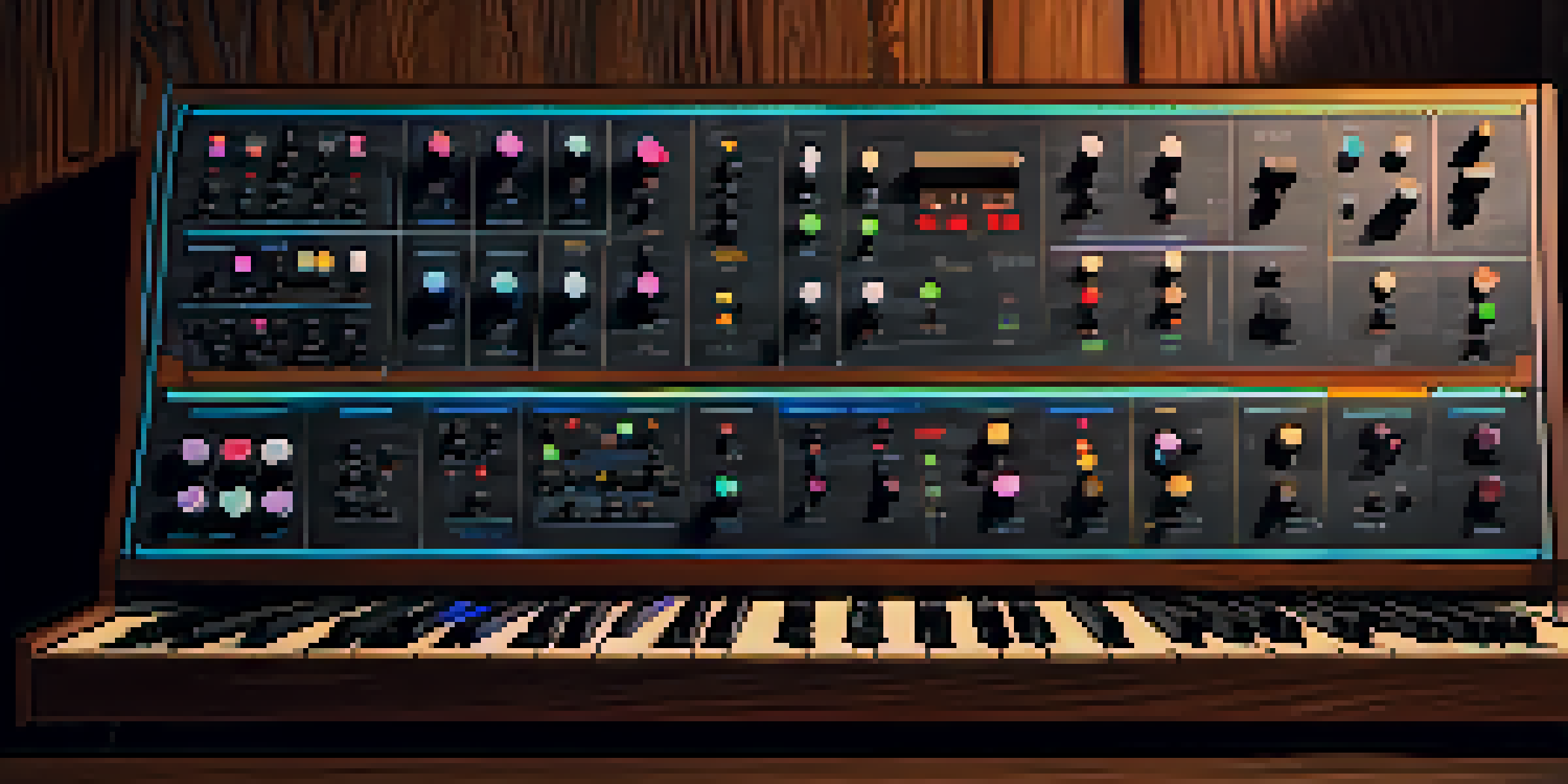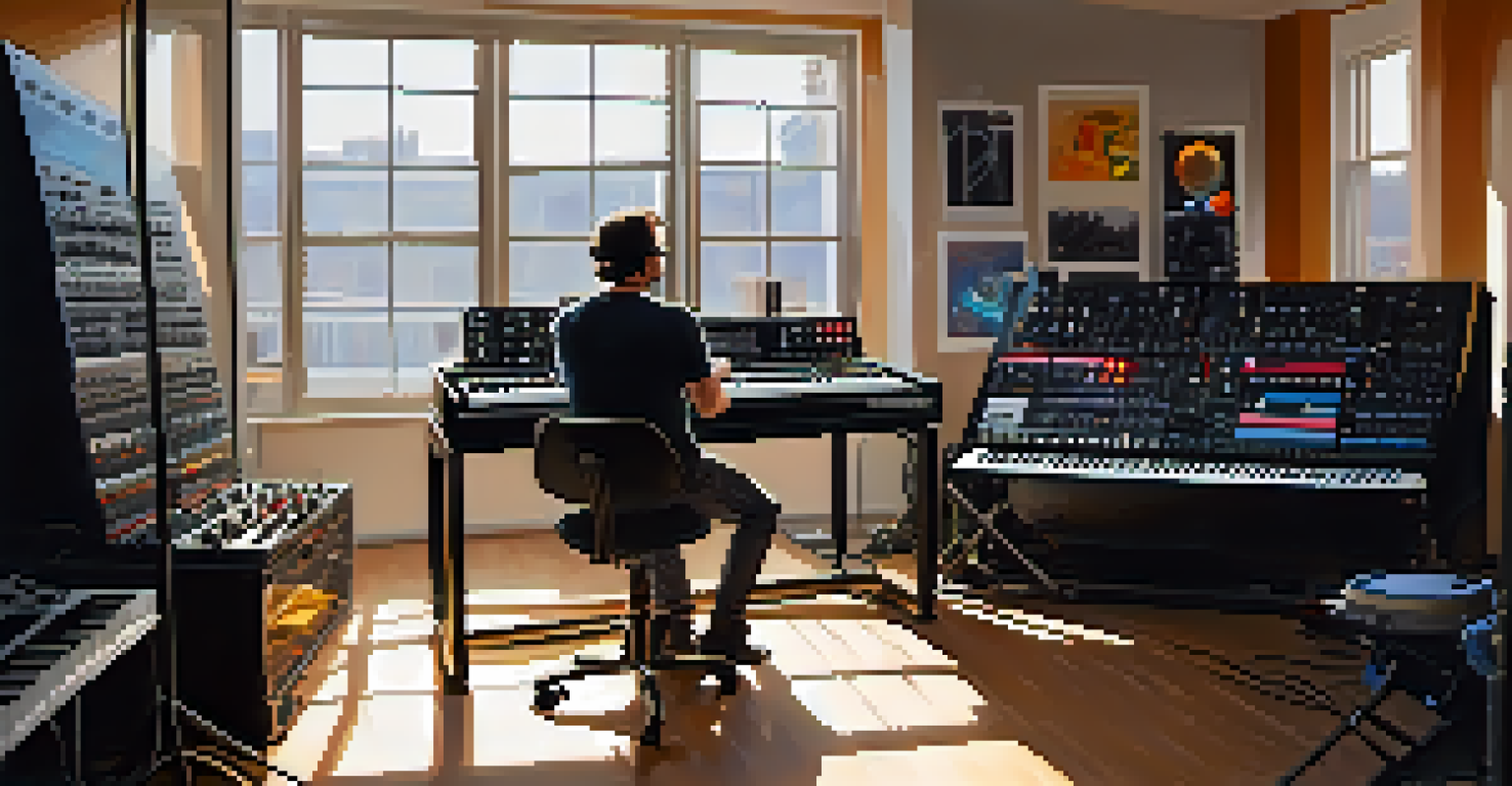Using Synthesizers: Crafting Original Sounds in Music Production

Understanding Synthesizers: The Basics and Beyond
Synthesizers are electronic instruments that generate audio signals to create sound. At their core, they use oscillators to produce waveforms, which can be shaped into a variety of tones. The beauty of synthesizers lies in their ability to imitate traditional instruments or create entirely new sounds that have never been heard before.
The synthesizer is a very powerful tool for creating sound and it allows you to express yourself in a very personal way.
There are several types of synthesizers, including analog, digital, and modular. Each type has its own unique characteristics, making them suitable for different styles of music production. For instance, analog synthesizers are known for their warm, rich tones, while digital synthesizers can produce a wider range of sounds.
Understanding the basics of synthesis can empower you to explore your creative potential. By learning about oscillators, filters, and envelopes, you can start to manipulate sound in ways that align with your artistic vision.
The Signal Chain: How Sound Travels in Synthesizers
In synthesizers, sound travels through a signal chain, which consists of various components that shape the final sound. This chain typically includes oscillators, filters, amplifiers, and effects units. Each element plays a crucial role in determining the overall character of the sound you create.

For example, oscillators generate the initial waveforms, while filters can cut off certain frequencies, adding texture and clarity. By adjusting these components, you can sculpt your sound to fit perfectly within your musical arrangement.
Basics of Synthesizers Explained
Synthesizers generate audio signals using oscillators to create a variety of tones, enabling both imitation of traditional instruments and the creation of unique sounds.
Understanding the signal chain is essential for anyone looking to craft original sounds. By manipulating each part of the chain, you can achieve a wide variety of tones, from bright and airy to dark and moody.
Exploring Sound Design: Creating Your Unique Voice
Sound design is the process of creating and manipulating audio to achieve specific sounds or effects. Synthesizers are powerful tools for sound design, allowing you to experiment with various parameters to create something truly unique. This is where your creativity can shine, as you explore different combinations and settings.
Music is an outburst of the soul.
To start your sound design journey, try tweaking the settings on your synthesizer. Adjust oscillator waveforms, play with filter resonance, or experiment with modulation to see how it affects the sound. Each small change can lead to a completely different outcome, making the exploration both exciting and rewarding.
Don't be afraid to break the rules and challenge conventional sound. Embrace the process of trial and error, and soon enough, you'll develop a signature sound that reflects your musical identity.
Layering Sounds: Building Richer Textures
One effective way to create a fuller sound in music production is by layering different synthesizer sounds. Layering involves combining multiple sounds to create a richer and more complex texture. This technique can add depth and dimension to your music, making it more engaging for listeners.
Start by choosing complementary sounds that blend well together. For example, you might layer a bright lead sound with a warm pad to create a lush atmosphere. By adjusting the volume and panning of each layer, you can achieve a balanced mix that enhances your overall production.
The Role of the Signal Chain
Understanding the signal chain in synthesizers, which includes oscillators, filters, and effects, is essential for shaping and sculpting your sound.
Experimenting with layering can transform your tracks from simple to sophisticated. With practice, you'll learn how to use layering strategically to elevate your music and create a captivating listening experience.
Effects Processing: Enhancing Your Synth Sounds
Effects processing is an essential part of music production that can elevate your synthesizer sounds. By applying effects such as reverb, delay, or distortion, you can add depth, space, and character to your tracks. These effects can transform a basic sound into something extraordinary.
For instance, adding reverb can create an ethereal quality, while delay can introduce rhythmic complexity. It's important to use effects judiciously, as over-processing can muddy your mix. Try to find a balance that enhances your sound without overwhelming it.
Exploring different effects and finding the right combination is key to developing your unique sound. Don't hesitate to experiment—sometimes the most unexpected effects can lead to the most exciting results.
MIDI and Automation: Bringing Your Sounds to Life
MIDI (Musical Instrument Digital Interface) is a protocol that allows electronic instruments and computers to communicate. This technology enables you to control your synthesizers more precisely and can significantly enhance your music production process. By using MIDI, you can create intricate melodies and rhythms that can be easily manipulated.
Automation is another powerful tool that allows you to change parameters over time. For example, you could automate the filter cutoff on a synth to create a dynamic build-up in your track. This technique not only adds movement to your sound but also keeps the listener engaged.
Sound Design and Personalization
Engaging in sound design through experimenting with synthesizer settings allows you to create unique audio experiences that reflect your musical identity.
Together, MIDI and automation provide endless possibilities for creativity. By mastering these tools, you can bring your synthesized sounds to life, transforming static notes into dynamic musical expressions.
Incorporating Synthesizers into Your Workflow
Integrating synthesizers into your music production workflow can seem daunting at first, but it’s a rewarding journey. Start by dedicating time to familiarize yourself with your synthesizer and its features. The more comfortable you become, the easier it will be to incorporate it into your projects.
Consider setting specific goals for your music production sessions, such as focusing on sound design or experimenting with effects. This approach can help you stay organized and make the most of your time with the synthesizer. Remember, consistency is key.

As you continue to experiment and refine your skills, you'll find that synthesizers can become an invaluable part of your creative process. Embrace the learning curve, and soon you'll be crafting original sounds that elevate your music to new heights.